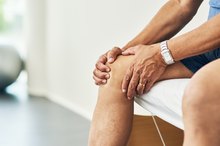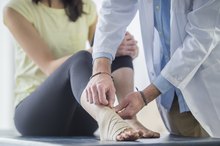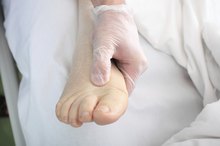How to Get Rid of Water Retention Fast
Water retention, or edema, occurs when abnormal amounts of fluid become trapped in the body tissues. It can occur anywhere in the body, but is most common in the legs, feet and hands. Edema may be linked to prolonged standing or sitting, pregnancy, or related to a medication side effect or certain serious medical conditions. Treatment is directed at the cause, and certain home measures can help improve mild swelling and increase the effectiveness of medication therapy. However, the impact of home measures on fluid retention is usually gradual, and not fast.
See Your Doctor
Management of fluid retention is directed at treating the underlying cause, so it's important to have your doctor assess this symptom and recommend a treatment plan -- which may include home measures, diuretic medications -- also called water pills -- and management of the causative factor 1. Since some causes of fluid retention are serious, don't start home treatment until you have had this medical assessment.
Elevate and Support
How to Reduce Swollen Legs & Feet
Learn More
If your swelling is in your legs, ankles or feet, your doctor may recommend that you elevate your legs above heart level for 30 minutes, several times each day, and place a pillow under your legs when you sleep. Your doctor may also ask you to wear support stockings, also called compression stockings, while standing or sitting for long periods of time. Compression garments, which apply gentle pressure and improve circulation, are also available to help prevent or manage swelling in other body areas, such as the arms. Be sure to ask your doctor about the right compression level for you, to ensure these garments are effective but not too tight.
Move and Stretch
If you stand or sit for long periods of time, you can experience swelling in your legs and feet. This effect can be more pronounced during hot weather, in pregnancy or if you have a condition that makes you more prone to fluid retention. Be sure to take breaks from prolonged standing, and if you sit all day at work, take stretch and exercise breaks to improve the circulation of blood and body fluids. Also, stay active and try to get daily exercise -- such as walking -- in order to improve circulation and prevent fluid buildup.
Reduce Sodium
How to Relieve Ankle Swelling Naturally
Learn More
Too much dietary sodium can lead to fluid retention, so cutting back on high-sodium foods, table salt and sodium-containing seasonings can help manage this edema. A sodium restriction is an essential part of your treatment plan if your swelling is caused by a serious medical condition, such as heart failure, or kidney or liver disease. Also, while most people with edema can drink fluids freely, in some cases your doctor may advise a fluid restriction to counter or prevent edema. If you need guidance on how to limit sodium or adjust your diet to manage a medical condition, ask your doctor for a referral to a dietitian.
Eat a Healthy Diet
Another way to help with edema is to increase potassium intake, as this mineral can help the body get rid of excess sodium -- and fluids. Eating a diet rich in fruits and vegetables is the most effective way to increase dietary potassium, but including whole grains, nuts, seeds and yogurt will also add more potassium to your diet. Other foods and herbs, such as asparagus, celery, onion, watermelon, eggplant and parsley, have been touted to have diuretic properties. While including these foods adds more nutrients to your diet, don't count on a predictable diuretic response -- as there is limited research on the amount needed to effectively manage edema.
Tips
While some dietary supplements are advertised to treat water retention, seek your doctor's advice before using these products. These supplements may not be effective and can be unsafe, particularly if they interact with any of your prescription medications or cause you to lose too much water or electrolytes.
Warnings
Discuss any swelling with your doctor, so you understand the cause and a targeted management plan. If your swelling is related to a known medical condition, such as heart, kidney or liver disease, and your water retention worsens, see your doctor right away. Seek immediate medical attention if swelling occurs suddenly, is accompanied by redness and is warm to the touch, or if you have shortness of breath, difficulty breathing or chest pain.
Reviewed by Kay Peck, MPH RD
Related Articles
References
- American Family Physician: Treatment of Edema
- Merck Manual: Edema
- American Journal of Physiology - Endocrinology and Metabolism: Cardiovascular Benefits Associated with Higher Dietary K+ vs. Lower Dietary Na+: Evidence from Population and Mechanistic Studies
- Adukauskiene D, Bivainyte A, Radaviciūte E. Cerebral edema and its treatment. Medicina (Kaunas). 2007;43(2):170-6.
- Cleveland Clinic. Edema.
- Ely, JW, Osheroff JA, Chamblis ML, et al. Approach to Leg Edema of Unclear Etiology. J Am Board Fam Med March 2006, 19 (2) 148-160; DOI: 10.3122/jabfm.19.2.148
- Familydoctor.org. Edema.
- Mayo Clinic. Pulmonary edema.
- Medline Plus. Edema.
- Medline Plus. Pulmonary Edema.
- National Eye Institute. Facts About Macular Edema.
- NCBI Bookshelf. Causes and signs of edema.
- Porter D. What is Macular Edema?
Resources
Writer Bio
Sharin Griffin has been a freelance writer since 2009, specializing in health-related articles. She has worked in the health-care industry as a certified nursing assistant and medical technician. Griffin's medical expertise encompasses bariatrics and geriatric care, with an emphasis on general medicine. She is completing an associate degree in health-care administration from Axia University.









